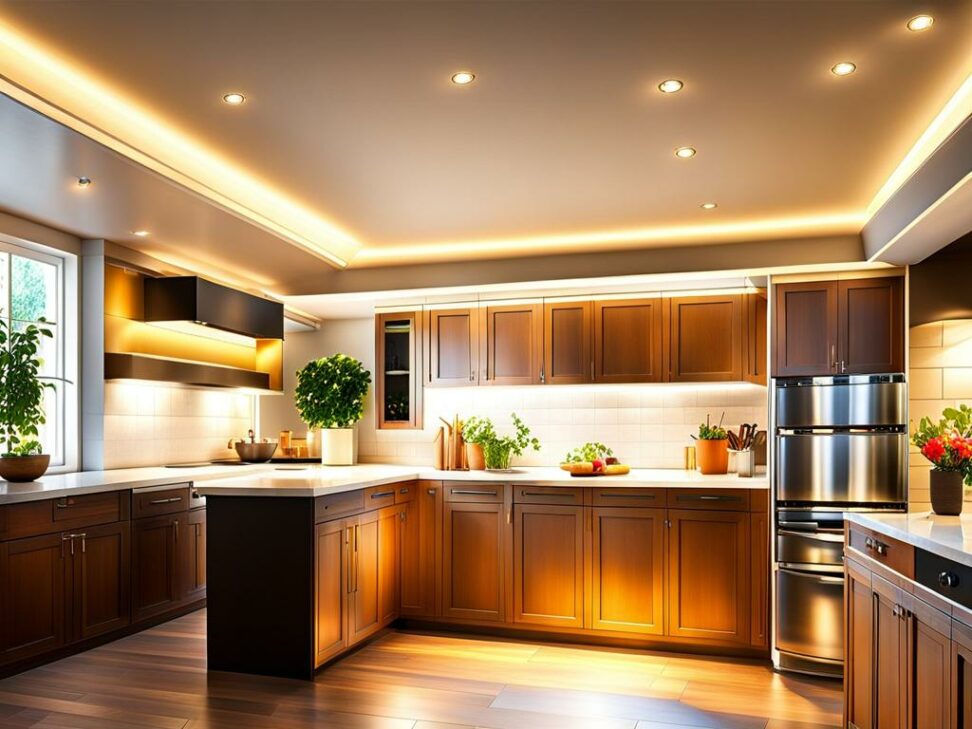Let There Be Light! How Can Lights Can Transform Your Kitchen
Tired of gloomy, dim kitchens? Bring your space to life with can lights! Installing recessed downlights can provide the bright, focused illumination needed for cooking, cleaning, and gatherings in the heart of your home. Read on to learn how strategic can lighting can upgrade both the function and aesthetic of your kitchen.
Can lights are versatile fixtures that recess into the ceiling, providing direct light ideal for task lighting. With flexible placement and features like dimming, the possibilities are endless for customizing the perfect lighting plan.
What Are Can Lights?
Can lights, also known as recessed lights or downlights, are circular fixtures that install into openings cut into the ceiling. This allows the body of the light to sit in the ceiling cavity with only the trim and bulb visible below. Available in LED, halogen and incandescent bulbs, can lights provide focused illumination directed straight down.
Key components of can lights include the housing, trim, bulb/socket and wiring. The housing is the canister that houses the inner workings and gets mounted above the ceiling. The trim is the visible part you see on the ceiling surface that covers the hole and bulb. Standard trims are made of metal or plastic, but for a unique look you can find glass, brass or other decorative trims.

Types of Can Lights
There are a few main options when selecting the light bulb and performance of can lights:
- LED - Energy efficient and long lasting. Designed to last up to 50,000 hours.
- Halogen - Provide bright, sparkling light. Run very hot.
- Incandescent - Traditional standard bulbs, not as efficient as LED.
Benefits of Using Can Lights in Kitchens
Recessed lighting offers many perks that make it a top choice for kitchen illumination:
- Focused bright light - The directed downward beam provides ideal task lighting over counters and islands.
- Flexible placement - Lights can be installed wherever illumination is needed.
- Energy efficient options - LED lights use significantly less energy and last longer than halogens.
- Stylish and discreet - Sleek cylindrical fixtures offer a clean, integrated look.
- Easy to install - Just cut a hole to recess housing into ceiling cavity.
Choosing the Right Can Lights
With so many options, it can get overwhelming when selecting can lights. Here are some key considerations as you plan your kitchen lighting:
Light Color
The color temperature, measured in degrees Kelvin (K), determines whether light appears warm or cool. For kitchens, a neutral white light in the 3000K to 4000K range is recommended. This provides a bright yet natural light that illuminates food prep areas without distorting colors.
Beam Angle
The beam angle refers to the angle of light dispersed from the bulb and reflects the fixture's spread. Narrow flood lights (40 degrees) concentrate light in a tight beam for illuminating specific tasks. Flood lights (60 degrees) cast a wider beam for general ambient lighting. Wide flood lights (90-120 degrees) provide broad illumination ideal for high or vaulted ceilings.
New Construction vs. Remodel Installs
Housings designed for new construction (NC) install before drywall, allowing the lip to hang down to fasten the can in place. For existing ceilings, remodel (REM) housings feature retention clips that spring against the ceiling hole to hold it flush. Insulation contact (IC) housings are also available for retrofits, allowing the fixture to safely touch insulation.
Dimming
Many can lights offer dimming capability, either with a dimmer switch or by wiring multiple fixtures to separate switches. This allows you to adjust the brightness as needed, from a soft glow for ambiance to full illumination for tasks.
Where to Install Can Lights in the Kitchen
When designing your kitchen lighting plan, consider adding can lights in these key areas:
Over Counters
Strategically place can lights over counters and prep areas for food chopping, cooking and mixing tasks. Space lights 2-3 feet apart for even coverage across the full counter run.
Over Kitchen Island
No kitchen island should be left in the dark! Make sure this secondary work space gets properly lit with recessed lighting as well.
Over Sink
Having bright focused light over the sink makes washing dishes and cleaning a breeze. Place a can light or two directly over the sink basin.
Inside Cabinets/Shelves
Installing small can lights on top cabinets or shelving units help highlight and showcase decorative items on display.
Focal Points
Use recessed lighting to accent and draw attention to prized artwork, architectural features or other focal points around the kitchen.
Creating a Lighting Plan
A lighting design combines three main types of illumination - ambient (general), task, and accent. For kitchens, you'll want ample task lighting over all work stations, supplemented by accent lighting to highlight features. Here are some tips for determining how many can lights you'll need and where to place them:
- Mark locations on the ceiling spaced 2-3 feet apart over counters, islands, sinks and other work areas.
- Plan for separate switches to divide lights into functional groups.
- Note ceiling obstructions like beams, vents or soffits that may affect placement.
- Have an electrician verify your lighting plan is feasible as designed.
Working With an Electrician
While savvy DIYers can handle basic can light installation, it's best to have a professional electrician on hand for certain circumstances like:
- New construction or major renovation projects
- Installing lights on vaulted ceilings
- Wiring multiple switches or dimmers
- Connecting lights across junction boxes
An experienced electrician can ensure all lights are properly wired and suited to your ceiling type for safe operation and code compliance.
Recessed downlighting delivers brilliant yet discreet illumination perfect for modern kitchen aesthetics. With strategic placement to highlight tasks and accent details, can lights can take your cooking space from dreary to dazzling.
Bring your lighting vision to life and enhance how you cook, socialize and live in your kitchen everyday. Let there be light!